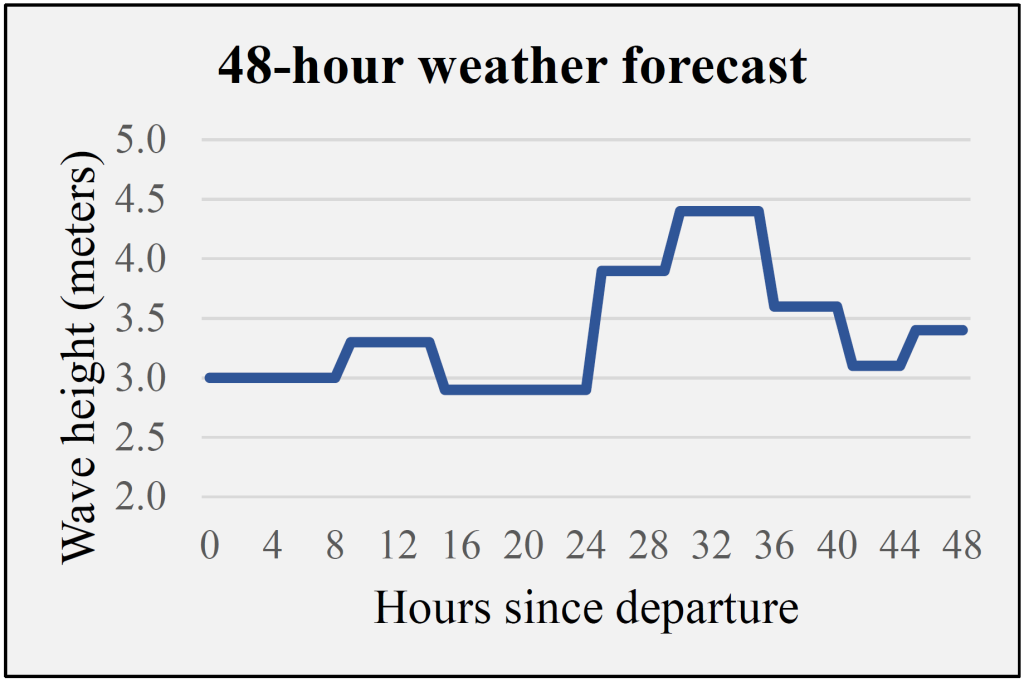The overall fleet of platform supply vessels (PSVs) contributes to approximately 1.5% of Norway’s total annual CO2 emissions. Weather impact affects the PSVs route planning and the performed voyages in terms of increased fuel consumption and hence, CO2 emissions. By thoroughly assessing the weather impact when planning routes for platform supply vessels, it is possible to reduce emissions from PSV operations by 15-20% and create more robust schedules performing better in a larger range of unpredictable operational conditions.
Offshore logistics planning: Routing and scheduling
Figure 1 shows a simplified planning scheme used to represent how a fleet of three PSVs vessels continuously operate on three different routes in a weekly, cyclic sailing plan in order to meet cargo demands at a set of eight different offshore installations.
Figure 1: A simplified planning scheme for PSV schedules in offshore logistics
In a real-life setting, this weekly schedule can rarely be performed due to sudden changes in requested orders from the offshore installations.
- Read more about the LowEmission Research Centre
Hence, the vessels need to be rescheduled, and key questions in this operational planning problem can be formulated as: Which PSVs should service which installations, in which sequence, in order to make operations as fuel-efficient as possible while still meeting the requested demands?
The illustration in Figure 2 provides a simple numerical example with a single PSV and five installations with demands as specified, highlighting the key features of the planning problem stated above.
Figure 2: A small example of operational planning.
It can easily be proven that the visiting sequence 1-5-4-3-2 (as shown) gives the optimal route (shortest distance sailed). This route should be performed within a period of 48 hours, in order to be repeatable in a weekly schedule. When considering also time required for cargo handling, the remaining time available for completing the route yields a required average sailing speed of 11 knots.
Weather dependency significantly complicates the planning process
If no considerations are made regarding the weather conditions during the period of performing the planned route, sailing every leg of the route at 11 knots will indeed be the least fuel-consuming alternative. However, we all know that there is no such thing as a day with completely calm seas in the North Sea. Once we account for the impact weather conditions have on the operation of PSVs, the least fuel-consuming schedule for a given route can only be found through a speed optimization process where speed can vary on every leg. The key feature of the weather-dependent speed optimization is that the fuel consumption curves for the vessels vary with time. Hence, the most fuel-efficient speed also changes with time, and speed selections for one leg will affect the fuel consumption curves on all later legs on the same voyage.
Figure 3: A 48-hour weather forecast representative for the winter months
Let’s assume a weather forecast over the next 48 hours as shown in Figure 3. When considering the impact of weather conditions to the fuel consumption at a sufficiently high level of detail, the optimal speed selections for the six legs of the route displayed in Figure 2 are found to be 9, 11, 13, 12, 7 and 12 knots respectively – the average speed for the entire route remains at 11 knots, but these speed selections yield a 15% reduction of fuel consumption, compared to maintaining a constant speed on the entire route.
Understanding the true weather impact on the PSVs is of great importance
There are numerous ways of evaluating weather impact to vessels, and in order to fully utilize the potential of weather-dependent speed optimization, precise models for calculating fuel consumption in a wide range of sea states are required. In my most recent work, I emphasize the importance of addressing several characteristics of a given sea state, and find that:
- Wave heights is the single most influential parameter that affects the PSV operations.
- At the same time, waves of a certain height can be very different in terms of energy density, which is dependent of the wave period.
- Lastly, the impact of wave direction has been assessed and found to have a large influence on the experienced weather impact to PSV operations.
Figure 4 shows how the maximum attainable speed for a PSV that can sail in 15 knots in calm water is reduced for waves of different significant wave heights (Hs). As seen, only small reductions of maximum attainable speed are seen in following seas.
Figure 4: Maximum attainable speed for a PSV in waves of different heights and directions.
A summary of key findings – how large savings can be achieved
Perhaps more precise than talking about emission reductions, is to discuss the magnitude of additional emissions that can be avoided by thoroughly assessing the weather impact when planning routes for platform supply vessels. In my computational experiments, I have evaluated 25 sailing routes to and from installations serviced from Mongstad supply base for a set of ten different weather forecasts. The main results can be summarized as follows:
- On average, additional CO2 emissions of 5-6% are observed when wave heights are used as the only parameter to quantify weather impact. If no weather impact considerations are made, additional emissions can be as high as 15-20%.
- The worse weather conditions, the greater is the importance of accounting for weather.
- PSV routes and schedules created in a weather-dependent routing framework are significantly more robust to sudden changes in weather or available sailing time on routes.













Comments
No comments yet. Be the first to comment!